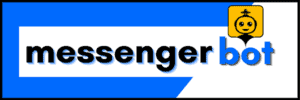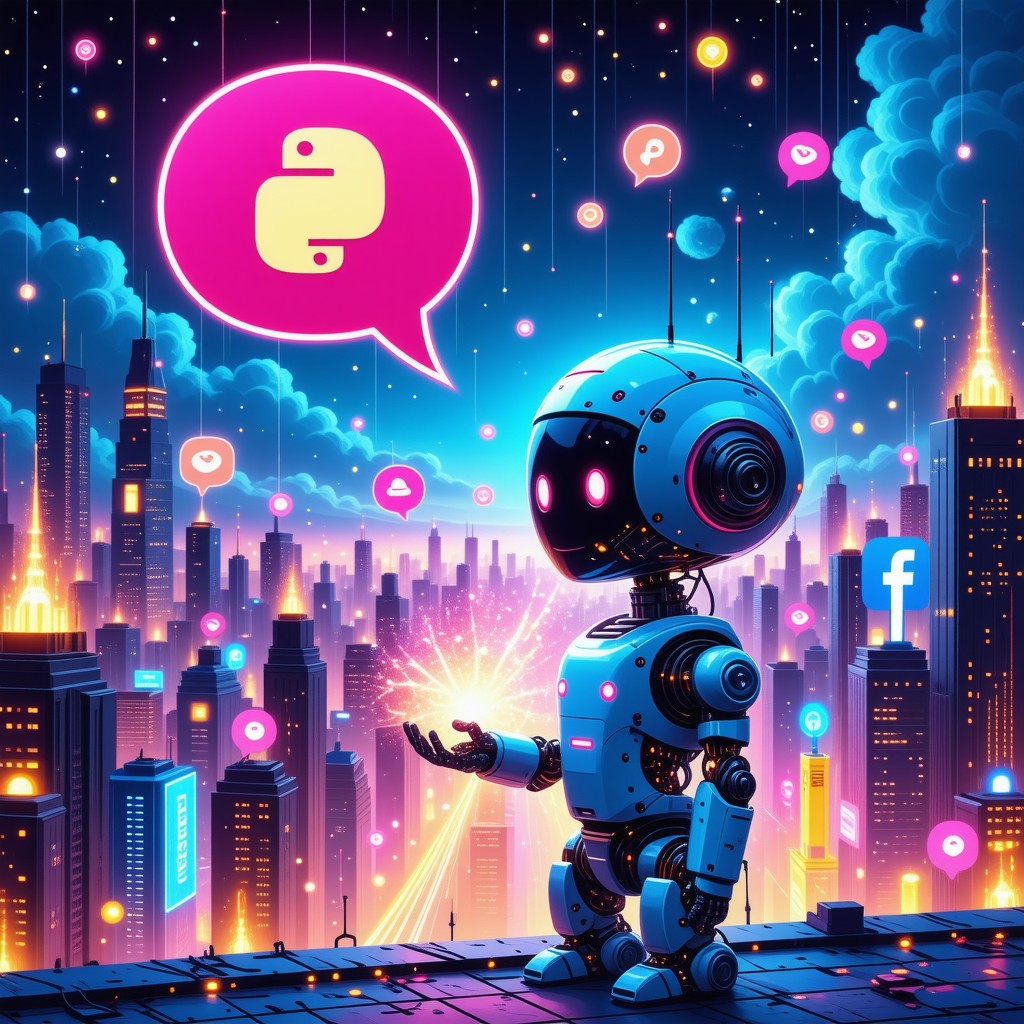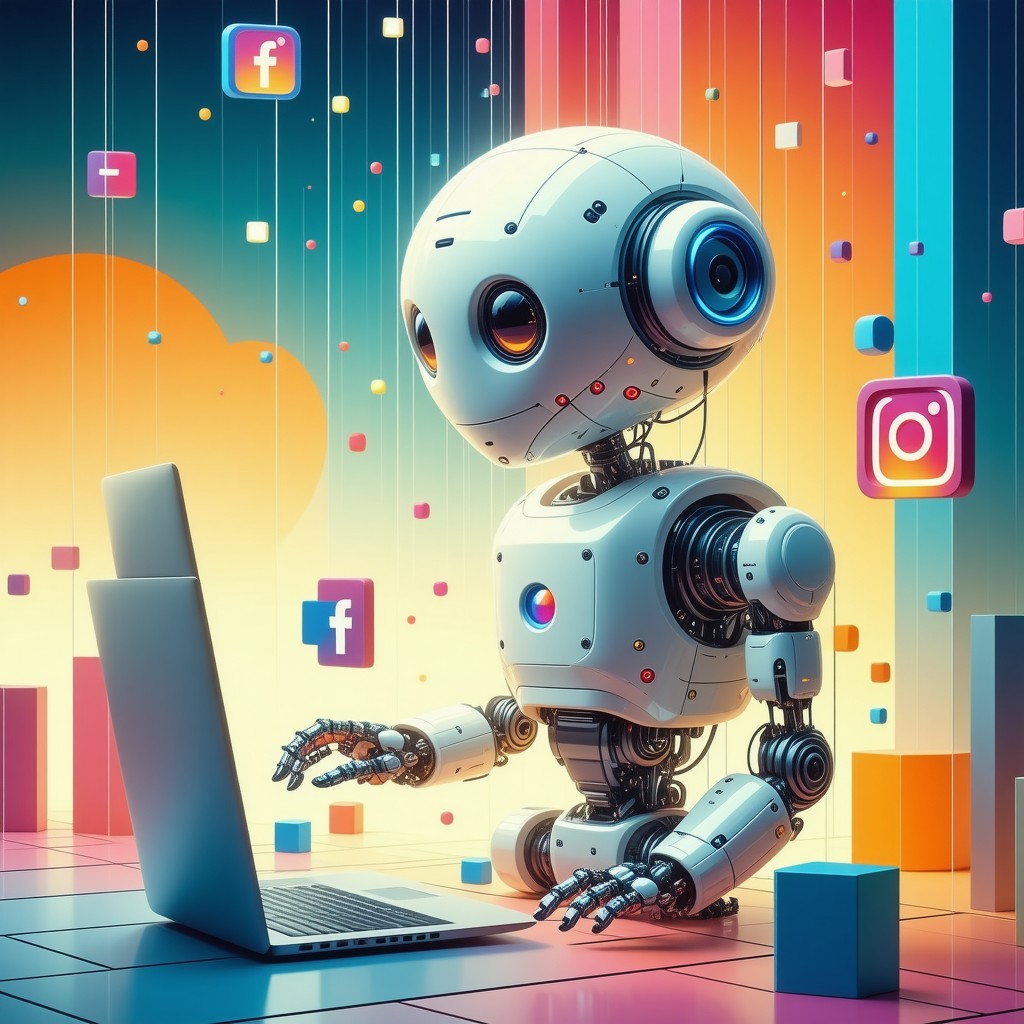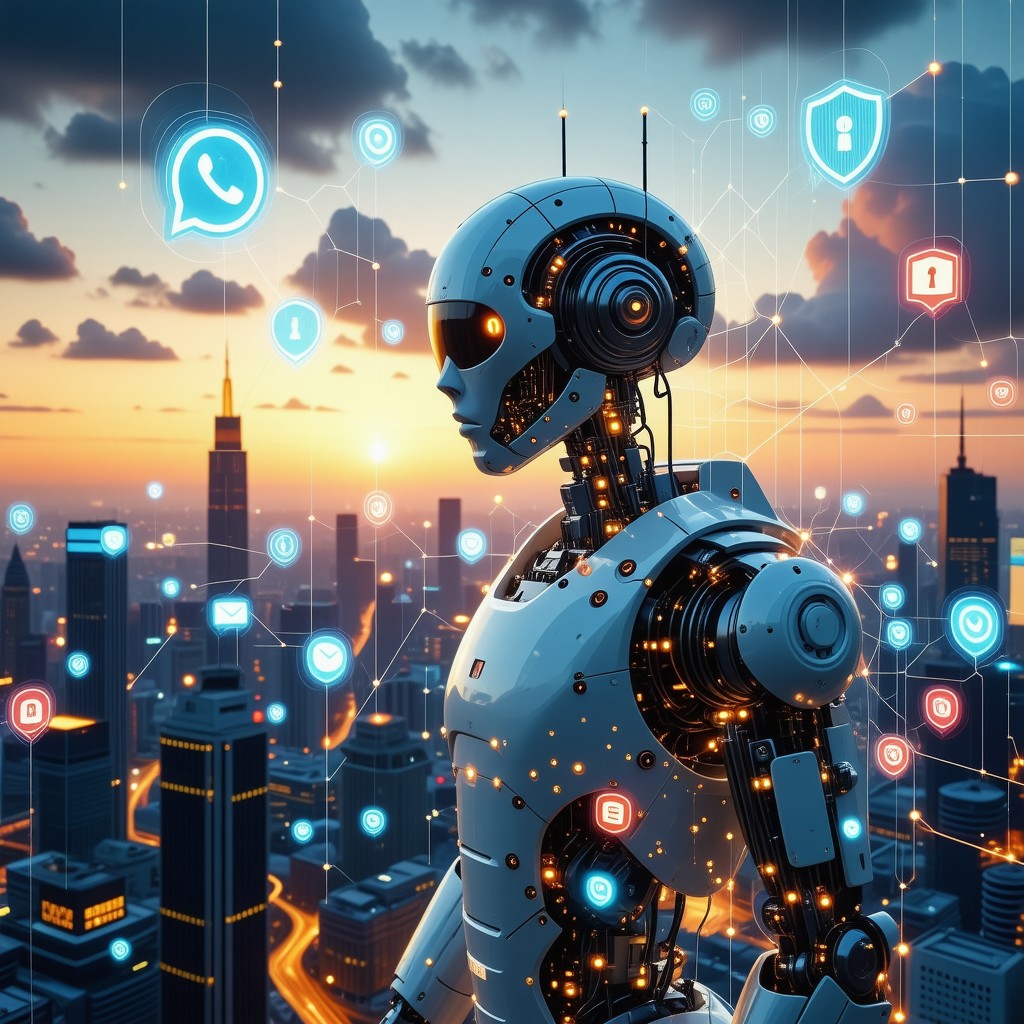Key Takeaways
- Build a Python Facebook Chatbot: Learn how to create engaging Messenger bots using Python to enhance user interaction and automate customer service.
- Seamless Messenger Integration: Discover how integrating chatbots within Facebook Messenger can improve response times and user satisfaction.
- Customization is Key: Personalize your chatbot to reflect your brand’s voice and provide tailored recommendations for a better user experience.
- Utilize Meta AI: Interact with Meta AI through your chatbot, enhancing engagement with advanced artificial intelligence capabilities.
- Leverage Open-Source Resources: Access valuable GitHub projects and tutorials to learn best practices in developing Python-based Facebook chatbots.
In today’s digital landscape, building a Python Facebook chatbot has become an essential skill for developers looking to enhance user engagement through Facebook Messenger. This comprehensive guide will walk you through the intricacies of creating a Messenger bot, exploring the vital role of chatbots within Facebook’s ecosystem. We will delve into whether Facebook has a chatbot, how to create one using Python, and the significance of Python in Facebook’s development. Additionally, we will examine the capabilities of Meta AI and how you can interact with it through chatbots. By the end of this article, you will not only understand the essential tools and best practices for developing a Facebook chatbot but also discover valuable resources, including open-source examples on GitHub. Join us as we unlock the potential of chatbots and elevate your engagement strategies with Meta AI.
Does Facebook have a chatbot?
Understanding Facebook’s Chatbot Ecosystem
Yes, Facebook does have a chatbot feature that allows businesses to automate interactions with customers through its Messenger platform. These chatbots can handle a variety of tasks, including answering frequently asked questions, providing customer support, and facilitating transactions. The integration of chatbots within Facebook Messenger enhances user engagement and streamlines communication, making it an essential tool for businesses looking to improve their customer service.
- Multilingual Support: Many Facebook chatbot platforms offer multilingual capabilities, enabling businesses to communicate with customers in their preferred languages. This feature is essential for companies with a global audience, as it enhances customer experience and engagement across different regions.
- Integration with Messenger: Facebook chatbots are integrated within the Messenger app, allowing for seamless communication. Businesses can create automated responses that engage users instantly, improving response times and customer satisfaction.
- Customization and Personalization: Chatbots can be customized to reflect a brand’s voice and personality. They can also use customer data to provide personalized recommendations, making interactions more relevant and engaging.
- Analytics and Insights: Facebook chatbots come with analytics tools that help businesses track performance metrics, such as user engagement and response rates. This data is crucial for optimizing chatbot interactions and improving overall customer service.
- Cost-Effective Solution: Implementing a Facebook chatbot can be a cost-effective way for businesses to enhance their customer service without the need for a large support team. Many platforms offer both free and paid options, catering to different business needs.
The Role of Chatbots in Facebook Messenger
Chatbots play a pivotal role in enhancing the functionality of Facebook Messenger. By automating responses and facilitating transactions, they allow businesses to maintain a constant presence and engage with customers around the clock. This automation not only improves efficiency but also ensures that users receive timely assistance, which is crucial in today’s fast-paced digital environment.
For further reading on the effectiveness of chatbots in customer service, you can refer to studies from sources like the Journal of Business Research and industry reports from platforms like HubSpot and Gartner.

How to create a Messenger bot in Python?
Creating a Facebook Messenger bot in Python involves several steps, including setting up your development environment, using the appropriate libraries, and understanding the Messenger API. Here’s a comprehensive guide to help you build your bot effectively.
Step-by-Step Guide to Building a Messenger Bot
1. Set Up Your Environment: Ensure you have Python installed (preferably version 3.6 or higher). Install the necessary library by running:
pip install fbchat
2. Import the Library: Start your Python script by importing the fbchat library:
from fbchat import Client
from fbchat.models import *
3. Login to Facebook: Use your Facebook credentials to log in:
username = "[email protected]" # Replace with your email
password = "your_password" # Replace with your password
client = Client(username, password)
4. Interact with Users: To fetch recent conversations, you can use:
users = client.fetchAllUsers()
for user in users:
print(user.name)
5. Sending Messages: You can send messages to users by specifying their user ID:
client.send(Message(text="Hello! This is your Messenger bot."), thread_id=user.uid, thread_type=ThreadType.USER)
6. Handling Incoming Messages: To respond to incoming messages, you will need to set up a listener. This can be done using the onMessage method:
class MyBot(Client):
def onMessage(self, author_id, message, thread_id, thread_type, **kwargs):
if author_id != self.uid:
self.send(Message(text="Thanks for your message!"), thread_id=thread_id, thread_type=thread_type)
7. Run Your Bot: Finally, run your bot by creating an instance of your bot class:
bot = MyBot(username, password)
bot.listen()
8. Additional Resources: For more advanced features, consider exploring the official Facebook Messenger API documentation. Check out community resources and tutorials on platforms like GitHub or Stack Overflow for practical examples and troubleshooting tips.
Utilizing the Facebook Messenger API with Python
The Facebook Messenger API is a powerful tool that allows developers to create interactive and engaging chatbots. By leveraging this API, you can enhance your Python Facebook chatbot’s capabilities significantly. Here are some key aspects to consider:
1. API Access: To use the Messenger API, you need to set up a Facebook App and obtain an access token. This token is essential for authenticating your bot’s requests to the API.
2. Webhook Configuration: Setting up a webhook is crucial for receiving messages and events from Facebook Messenger. This involves providing a URL where Facebook can send incoming messages, allowing your bot to respond in real-time.
3. Message Formatting: The API supports various message formats, including text, images, and buttons. Understanding how to format your messages will enhance user interaction and engagement.
4. Rich Media and Quick Replies: Utilize rich media elements and quick replies to create a more engaging experience for users. This can help in lead generation and improving user satisfaction.
5. Analytics and Optimization: Monitor your bot’s performance using the analytics provided by the Messenger API. This data can help you optimize your bot’s responses and improve user engagement over time.
By following these guidelines and utilizing the Facebook Messenger API effectively, you can create a robust and interactive Messenger bot in Python that meets your business needs. For further insights, explore our comprehensive guide to Messenger Python bots and discover more about chatbot development for Facebook Messenger.
Does FB use Python?
Yes, Facebook (now Meta Platforms, Inc.) utilizes Python extensively within its infrastructure. Python ranks as the third most popular programming language at Facebook, following PHP and C++. This widespread use underscores Python’s versatility and effectiveness in various applications across the platform.
The Importance of Python in Facebook’s Development
Python plays a critical role at Facebook, supporting various functions from infrastructure management to advanced data analytics. Here are some key areas where Python is essential:
- Infrastructure Maintenance: Production engineers at Facebook leverage Python to manage and maintain a vast array of libraries and binaries crucial for the platform’s infrastructure. This includes automating tasks, data analysis, and system monitoring, which enhances operational efficiency.
- Data Analysis and Machine Learning: Python’s rich ecosystem of libraries, such as NumPy, Pandas, and TensorFlow, enables Facebook to perform complex data analysis and implement machine learning algorithms. This is vital for features like personalized content delivery and ad targeting.
- Rapid Prototyping: The flexibility and simplicity of Python allow Facebook developers to quickly prototype new features and applications, facilitating innovation and faster deployment cycles.
- Integration with Other Technologies: Python is often used in conjunction with other programming languages and technologies at Facebook, enhancing its capabilities in various projects, including backend services and data processing pipelines.
- Messenger Bots: While not the primary focus, Python can be utilized in developing Messenger Bots, allowing for the creation of automated responses and interactions within the Messenger platform, showcasing its versatility in enhancing user engagement.
Examples of Python Applications within Facebook
Facebook employs Python in numerous applications that enhance user experience and operational efficiency. Some notable examples include:
- Content Delivery: Python is used to analyze user behavior and preferences, enabling Facebook to deliver personalized content effectively.
- Ad Targeting: The platform utilizes Python for sophisticated algorithms that optimize ad placements based on user data, improving advertising effectiveness.
- Data Processing: Python scripts are integral to processing large datasets, allowing Facebook to derive insights and improve its services continuously.
- Chatbot Development: Developers can create Python-based chatbots for Facebook Messenger, enhancing user interaction through automated responses and support.
In summary, Python’s integration into Facebook’s development processes is vital for maintaining its infrastructure, enhancing data analysis capabilities, and fostering innovation. For those interested in building Messenger bots with Python, the language offers a robust framework for creating effective and engaging automated solutions.
Can I chat with Meta AI on Facebook?
Yes, you can chat with Meta AI on Facebook. Engaging with Meta AI offers a unique experience, allowing users to interact with advanced artificial intelligence directly through Facebook Messenger. This interaction not only enhances user engagement but also showcases the capabilities of AI in managing conversations effectively.
Exploring Meta AI’s Capabilities in Messenger
Meta AI is designed to provide users with a seamless chatting experience. Here are some of its key capabilities:
- Accessing Meta AI: If you have previously interacted with Meta AI or an AI character, you can find these chats in your Chats list on Facebook Messenger. Simply open the Messenger app or website and look for the conversation.
- Starting a New Chat: To initiate a new conversation with Meta AI, open Messenger and search for “Meta AI” in the search bar. Select the official Meta AI account to begin chatting.
- Personalization Features: Meta AI can remember details about you during your conversations. This feature allows for a more personalized experience, as the AI can tailor responses based on your previous interactions.
- Using Messenger Bots: While chatting with Meta AI, you may also encounter Messenger Bots that provide additional functionalities. These bots can assist with various tasks, such as answering questions, providing recommendations, or facilitating transactions.
For more detailed guidance, you can refer to the official Facebook Help Center, which offers comprehensive information on using Meta AI and Messenger features effectively.
How to Interact with Meta AI through Chatbots
Interacting with Meta AI through chatbots can enhance your experience on Facebook Messenger. Here’s how to make the most of it:
- Explore Various Bots: Many chatbots are integrated with Meta AI, providing diverse functionalities. These bots can help you with customer service inquiries, product recommendations, and more.
- Utilize AI Features: Take advantage of the AI’s ability to learn from your interactions. The more you engage, the better it becomes at understanding your preferences and needs.
- Feedback Mechanism: Provide feedback on your interactions with Meta AI. This helps improve the AI’s responses and overall functionality, creating a better user experience.
By leveraging these features, you can enhance your communication on Facebook Messenger, making it more efficient and enjoyable. For those interested in building their own Messenger bots, there are numerous resources available to guide you through the process.

How to create a Facebook chat bot?
Creating a Facebook chatbot is an exciting venture that can significantly enhance user engagement on your Facebook page. By leveraging the capabilities of a Python Facebook chatbot, you can automate interactions and provide real-time responses to your audience. Here’s a detailed guide on how to get started.
Essential Tools for Building a Facebook Chatbot
To create a Facebook chatbot, you’ll need to utilize specific tools and platforms that facilitate the development process. Here’s a step-by-step approach:
- Sign up for a chatbot building platform: Consider using platforms like Chatfuel or ManyChat, which are popular for creating Facebook chatbots without coding.
- Connect your Facebook account: Integrate your Facebook account with the chosen chatbot builder. This connection allows the bot to interact with users on your Facebook page.
- Link the chatbot to your Facebook business page: Ensure you have admin access to your page to facilitate this connection.
- Follow the in-app tutorial: Most chatbot builders provide tutorials that guide you through essential features and functionalities.
- Design your chatbot’s welcome message: Craft engaging messages that set the tone for user interactions.
- Set up conversation navigation: Create blocks or flows that guide users through various topics or services, enhancing user experience with quick replies and buttons.
- Test your chatbot: Ensure it responds accurately to user inquiries and make adjustments based on feedback.
- Launch your chatbot: Promote it on your Facebook page to encourage user engagement and monitor interactions for continuous optimization.
For a more comprehensive guide on building a Facebook Messenger bot with Python, check out our detailed resources.
Best Practices for Developing a Facebook Messenger Chatbot
To ensure your Facebook Messenger chatbot is effective and user-friendly, consider the following best practices:
- Keep interactions natural: Design your chatbot to mimic human conversation, making it easier for users to engage.
- Utilize AI capabilities: Implement AI-driven responses to enhance the chatbot’s ability to handle diverse inquiries.
- Monitor performance: Regularly analyze user interactions and feedback to refine the chatbot’s responses and functionalities.
- Incorporate multilingual support: If your audience is diverse, ensure your chatbot can communicate in multiple languages, enhancing accessibility.
- Integrate with e-commerce tools: If applicable, use features that support direct selling and cart recovery to streamline the shopping experience.
For further insights on Python Facebook chatbot GitHub resources, explore our tutorials on comprehensive guide to Messenger Python bots.
Is Meta chatbot free?
Yes, Meta’s chatbot, known as Meta AI, is completely free to use. Meta AI is designed to facilitate conversations and provide assistance across various platforms, including Facebook Messenger. This chatbot leverages advanced artificial intelligence to understand and respond to user queries effectively.
Understanding the Cost Structure of Meta Chatbots
The cost structure of Meta chatbots is straightforward, as they are offered at no charge to users. This accessibility allows businesses and individuals to leverage Meta AI without incurring expenses, making it an attractive option for enhancing customer engagement. The primary investment lies in the development and integration of the chatbot into existing systems, which can be achieved using tools like Python for building a Facebook chatbot. By utilizing the step-by-step guide to building a Facebook Messenger bot with Python, users can create effective chatbots that utilize Meta AI’s capabilities.
Free Resources for Building a Python Facebook Chatbot
For those interested in creating a Python Facebook chatbot, numerous free resources are available. These resources include tutorials, documentation, and community support that can guide you through the development process. Platforms like Messenger Bot tutorials provide comprehensive insights into building and deploying chatbots effectively. Additionally, leveraging GitHub can offer access to open-source projects and examples of Python Facebook chatbots, allowing developers to learn from existing code and enhance their own implementations. By utilizing these free resources, you can develop a robust chatbot that meets your needs without significant financial investment.
Python Facebook chatbot GitHub
Exploring open-source projects on GitHub can significantly enhance your understanding of building a Python Facebook chatbot. GitHub hosts a variety of repositories that showcase different implementations and functionalities of chatbots tailored for Facebook Messenger. By examining these projects, you can gain insights into coding practices, architecture, and integration techniques that are essential for developing your own chatbot.
Exploring Open Source Python Facebook Chatbot Examples
There are numerous open-source examples available on GitHub that demonstrate how to create a Facebook Messenger chatbot using Python. These repositories often include comprehensive documentation, making it easier for developers to understand the setup process and functionality. Some notable examples include:
- Example Chatbot 1: A simple implementation that showcases basic interaction capabilities.
- Example Chatbot 2: This project includes advanced features such as natural language processing and user intent recognition.
- Example Chatbot 3: Focused on integrating with external APIs to provide dynamic responses based on user queries.
By studying these examples, you can learn how to structure your code, manage dependencies, and utilize the Facebook Messenger API effectively. Additionally, these repositories often have active communities that can provide support and feedback as you develop your own chatbot.
How to Leverage GitHub for Your Chatbot Development
Leveraging GitHub for your Python Facebook chatbot development involves several key strategies:
- Forking Repositories: Start by forking existing projects that align with your goals. This allows you to experiment with the code while maintaining a reference to the original project.
- Contributing to Projects: Engage with the community by contributing to existing repositories. This can enhance your skills and help you build a network of fellow developers.
- Creating Your Own Repository: Once you have developed your chatbot, consider creating your own GitHub repository. This not only showcases your work but also allows others to learn from your implementation.
Utilizing GitHub effectively can streamline your development process and provide valuable resources as you create your Python Facebook chatbot. For a detailed guide on building a Facebook Messenger bot with Python, check out our comprehensive guide to Messenger Python bots.




